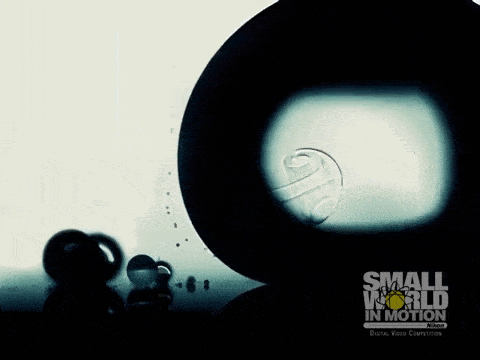
You often hear the phrase ‘we’re all made of water’. Technically, the human body is 60% water, and some organisms are 90% water — and that’s thanks to the blessing of having water virtually all around us in all its phases: solid, liquid, or gas. But sometimes you want to keep water and water-loving creatures away. That’s what Kazi Rabbi and Xiao Yan, both at the University of Illinois at Urbana-Champaign, have been working on for the last couple of years.
Their research is focused on designing surfaces that enhance the condensation and evaporation of liquids. But aside from its tangible, practical applications, this work also won the researchers’ first prize for the annual Nikon Small World in Motion Photomicrography Competition. At its 10th edition, the competition honors science videos that show visual stunning processing from nature’s microcosmos.
Using transmitted light microscopy, the pair of researchers recorded micro-droplets made of 80% water and 20% ethanol coalescing. The video below is slowed down 200 times.
“Think about anything from keeping the pipes from freezing in winter to making your air conditioning unit run more efficiently,” Rabbi explained in a press release, “If we can develop surfaces and materials that better repel liquids, we can create appliances, power systems, and other technologies that require less energy to run. It could lead to a more sustainable future.”
“Much of our microscopy is focused on visualizing how liquid droplets or condensate droplets interact with such surfaces at micro scale.” Yan said. This visualization is no easy feat to capture. The surface the droplets in the video are reacting to is one of Rabbi and Yan’s own design.
Second place went to Richard Kirby, a marine biologist whose research focuses on plankton and their environments, who recorded a darkfield video of a horseshoe worm larva.
Third place went to a video showing a cytoplasmic stream inside onion cells. This one is actually my personal favorite because I just love how space-like it is. Often, when you zoom in or zoom out a great deal, nature has the knack of being fascinatingly consistent.
Fourth place went to Martin Kaae Kristiansen for a polarized light video showing a blackworm displaying peristaltic movements, while Andrew Moore and Pedro Guedes-Dias from the Howard Hughes Medical Institute snapped fifth place for their visualization of fluorescent actin expressed in an embryonic rat hippocampal neuron.
Share your favorites in the comment section.









